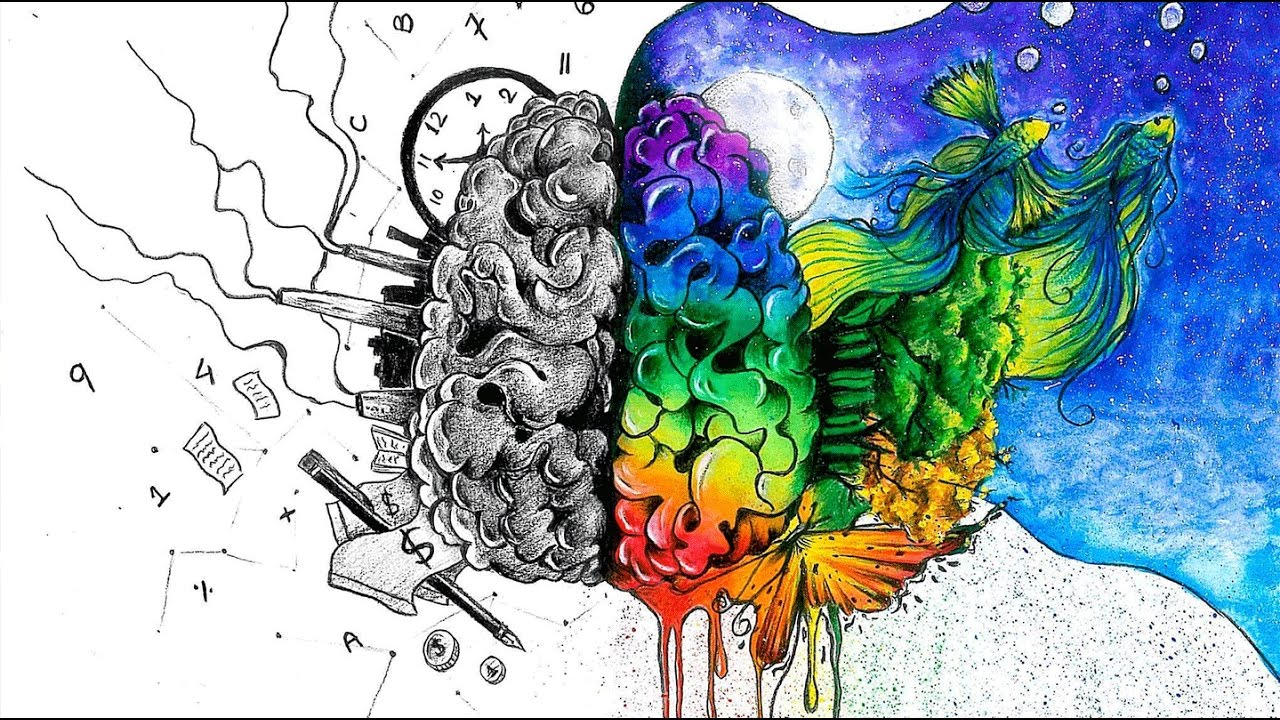The Left Brain vs Right Brain Myth Analysis Art
This is a new style of video I’m testing. This video discusses the myth of the left brain vs the right brain and the characteristics associated with it. Leave a comment below if you liked it, if you want more, or if you liked it and don’t want more!
Script written by: Madison Kate Stafford
Painter: Nadir Chen Siddiqui
Image: https://imgur.com/a/OA2xu
Insta: https://www.instagram.com/practical_psych/
Twitter: https://twitter.com/practical_psych
Facebook: https://www.facebook.com/practicalpsych
A well-known term among psychologists, scientists, and even modern culture is “left-” and “right-“ brain. You may have heard one of these terms yourself, as a means of someone else describing you. Maybe someone remarked upon your amazing math skills, telling you how you’re a left-brain thinker; or maybe you painted an awe-inspiring picture, and someone remarked upon your right-brain thinking talents. You may have even taken a test to determine which brain hemisphere you’re more oriented to, if you’ve stumbled upon this topic on your own.
So, what do the terms ‘left-brain’ and ‘right-brain’ mean?
Often times, ‘left-brained’ is a term used to describe logical, analytical, and calculating individuals; for example, scientists, mathematicians, lawyers, accountants, and most people who work with technology are all people who could be considered “left-brained”. On the other hand (or hemisphere), ‘right-brained’ is often used to describe creative, intuitive, and emotionally-based people; for example, artists, psychologists, graphic and interior designers, song-writers, as well as art therapists. “Left” and “right” brain are both phrases used for labeling, but also for scientific purposes. Scientists and neuropsychologists alike have studied the two hemispheres of the brain for over five decades; with the pioneer of the study, Roger Wolcott Sperry, being given a Nobel Prize in 1981 for his work with split-brain research. Nobelprize.org summarizes Sperry’s work as, “…One way [Sperry] studied these functions was by examining patients whose hemisphere-connecting nerves had been severed to alleviate serious epilepsy. By the 1960s, he could reveal that the left hemisphere is more geared toward abstract and analytical thought, calculation, and linguistic ability, while the right hemisphere is more important for comprehending spatial patterns and complex sounds like music.”
If left-brained thinking is considered digital thinking, focusing on topics such as calculation and analysis of the world; and right-brained thinking is considered analog thinking, focusing on topics such as art and creativity, you might be wondering if it’s possible for a person to be both left-brain and right-brain thinkers, or mentally ambidextrous. You might think you’re mentally ambidextrous yourself, neither 100% left-brained, nor 100% right-brained. If so, don’t worry, there is such a thing as mental ambidexterity. In fact, most successful and innovative people practice using both their left and right brain hemispheres.
So maybe rather than a person’s characteristics being categorized into their dominant brain hemisphere, this can now be seen simply as their personality traits. It is more likely than not that individuals are merely more logic-oriented or creativity-focused, rather than using one hemisphere of their brain only. This evidence can also be found in taking a look at a brain hemisphere model chart; some (and most) people possess a mixture of the traits, characteristics, and skills listed on left and right brain charts. It is very rare, and often fictional, to find a person who completely fits into one category of a brain hemisphere. Some people are talented at math, but also very good at creating artistic pieces. Other people are very analytical, but can also use their imagination to varying extents. Cheri Cheng at counselheal.com confirms this idea, writing, “Everyone should understand the personality types associated with the terminology ‘left-brained’ and ‘right-brained’ and how they relate to him or her personally; however, we just don’t see patterns where the whole left-brain network is more connected or the whole right-brain network is more connected in some people. It may be that personality types have nothing to do with one hemisphere being more active, stronger, or more connected,” said researcher Jared Nielsen.”
The general verdict is this: in the 1960’s, Sperry’s research may have been (and most likely was) true. However, in modern times, the idea of left and right brain thinking has been debunked. It is now more a matter of opinion, and what you wish to believe. The fact of the matter is; science, neuroscience, and psychology as a whole are consistently coming up with new ideas, facts, and information. Scientifically, what may be true today, could be proven incorrect tomorrow.
Check out MY Passive Income Ebook: http://bit.ly/PsychologyIncome



![[ID: jbg27OglVUQ] Youtube Automatic](https://okumasaati.net/wp-content/uploads/2020/10/id-jbg27oglvuq-youtube-automatic-360x203.jpg)
![[ID: SzJcy6ZuZwI] Youtube Automatic](https://okumasaati.net/wp-content/uploads/2020/10/id-szjcy6zuzwi-youtube-automatic-360x203.jpg)
![[ID: wI-75c9gkXs] Youtube Automatic](https://okumasaati.net/wp-content/uploads/2020/10/id-wi-75c9gkxs-youtube-automatic-360x203.jpg)
![[ID: gZj176ZoM4Y] Youtube Automatic](https://okumasaati.net/wp-content/uploads/2020/10/id-gzj176zom4y-youtube-automatic-360x203.jpg)
![[ID: NU9ajgqYag8] Youtube Automatic](https://okumasaati.net/wp-content/uploads/2020/10/id-nu9ajgqyag8-youtube-automatic-360x203.jpg)
![[ID: YFChAYxqga4] Youtube Automatic](https://okumasaati.net/wp-content/uploads/2020/10/id-yfchayxqga4-youtube-automatic-360x203.jpg)